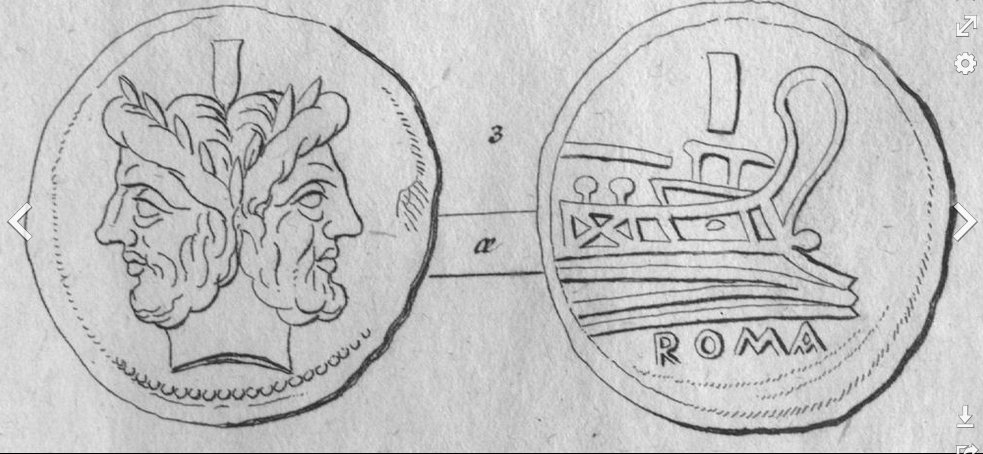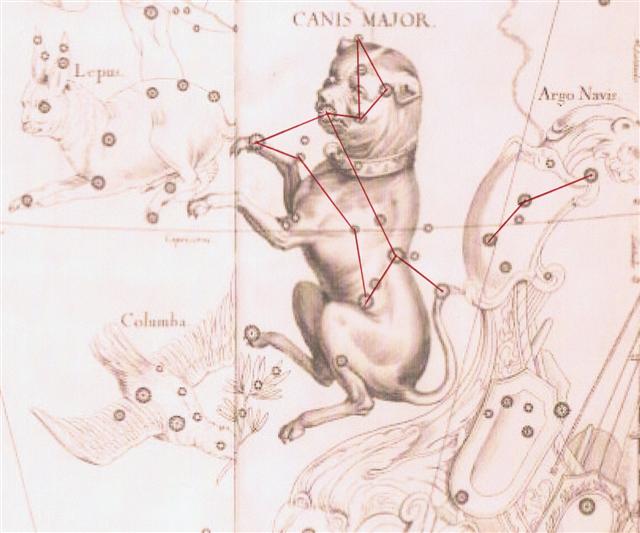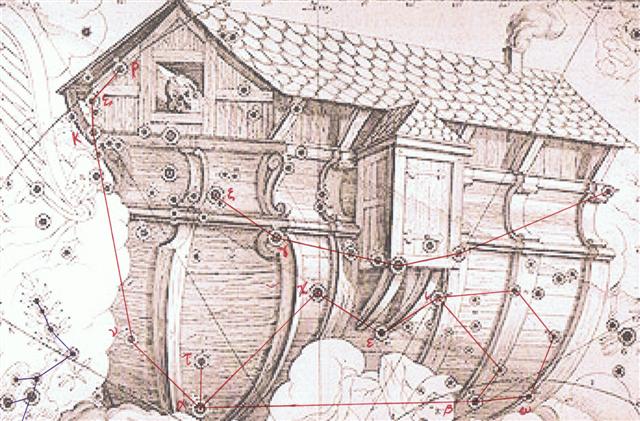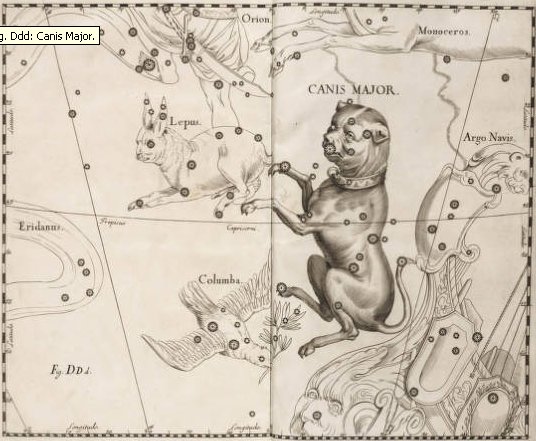On one side of the coin of
the year
was Janus and at the other side was what remained of Argo Navis:

The keel (Carina) of the ancient
ship began at Canopus, so much is clear. In the preceding day
- and at the perfect first little Rei in the text - was Furud (ζ Canis
Majoris). The toe of the hind right paw of the Great Dog was above the
green branch carried by Columba as a Sign to Noah in his Ark.
|
Manacle |
ziqq |
Phoenician zayin |
 |
Greek
zeta |
Ζ (ζ) |
|
...
Zeta (uppercase
Ζ,
lowercase ζ;
Greek:
ζήτα
... is the sixth letter of the Greek alphabet. In
the system of Greek numerals, it has a value of 7.
It was derived from the Phoenician letter Zayin.
Letters that arose from zeta include the Roman Z and
Cyrillic З
...
Zayin
(also spelled Zain or Zayn or simply
Zay) is the seventh letter of many Semitic
abjads ... It represents the sound
[z]. The Phoenician letter appears to be
named after a sword or other weapon. (In Biblical
Hebrew, 'Zayin' means sword, and the verb 'Lezayen'
means to arm. In modern Hebrew, 'zayin' means
penis and 'lezayen' is a vulgar term which
generally means to perform sexual intercourse and is
used in a similar fashion to the English word fuck,
although the older meaning survives in 'maavak
mezuyan' (armed struggle) and 'beton
mezuyan' (armed, i.e., reinforced concrete). The
Proto-Sinaitic glyph according to Brian Colless may
have been called ziqq, based on a hieroglyph
depicting a 'manacle'. |

|
APRIL 17
(107) |
18 |
19 |
20 (*30) |
21 |
|
APRIL 13 |
14 |
15 |
16 (*26) |
17 (107) |
 |
 |
 |
 |
 |
|
Ga1-27 |
Ga1-28 |
Ga1-29 |
Ga1-30 |
Ga2-1 |
|
6h
(91.3) |
ξ Orionis (92.5) |
Al
Han'ah-4 /
Maru-sha-pu-u-mash-mashu-7 |
FURUD
(94.9) |
Well-22
/
Arkū-sha-pu-u-mash-mashu-8 |
|
ν
Orionis (91.4), θ Columbae (91.5), π Columbae (91.6) |
TEJAT
PRIOR
(93.4), γ Monocerotis (93.5), κ Aurigae (93.6), κ
Columbae (93.8) |
δ
Columbae (95.2),
TEJAT POSTERIOR,
Mirzam (95.4),
CANOPUS
(95.6), ε Monocerotis (95.7), ψ1 Aurigae (95.9) |
|
SOLSTICE |
June 23
(174) |
ST
JOHN'S EVE |
|
'May 24
(*64) |
25 |
26 |
27 |
28 (*68) |
|
NAKSHATRA DATES: |
|
OCTOBER
17 (290) |
18 |
19 |
20 |
21
(*214) |
|
OCTOBER
13 |
14 |
15 (288) |
16 |
17
(*210) |
|
Zhōngshān (274.0), π
Pavonis (274.6) |
ι Pavonis (275.1),
Polis (275.9)
MENKAR
|
η
Sagittarii (276.9) |
Purva
Ashadha-20 |
|
KAUS
MEDIUS, κ Lyrae
(277.5), Tung Hae (277.7), Shaou Pih (277.8), Kwei
She (277.9) |
φ Oct. (278.1),
KAUS
AUSTRALIS
(278.3), ξ Pavonis (278.4), Al Athfar (278.6) |
|
SOLSTICE |
December
23 (357) |
CHRISTMAS EVE |
|
'November 23
(327) |
24 |
25 |
26 |
27
(*251) |
|
APRIL 22 |
23 |
24 |
25 (*35) |
26 |
27 |
(118
= 4 * 29½) |
|
APRIL 18 |
19 |
20 |
21
(*31) |
22 |
23 |
(116
= 4 * 29) |
 |
 |
 |
 |
 |
 |
 |
|
Ga2-2 |
Ga2-3 |
Ga2-4 |
Ga2-5 (35) |
Ga2-6 |
Ga2-7 |
Ga2-8 |
|
no
star listed (96) |
β
Monocerotis, ν Gemini (97.0) |
no
star listed (98) |
ν
Puppis (99.2), ψ3 Aurigae (99.4), ψ2 Aurigae
(99.5)
GEMMA
|
ψ4
Aurigae (100.5), Mebsuta (100.7) |
SIRIUS
(101.2), ψ5 Aurigae (101.4), ν Gemini (101.6),
ψ6 Aurigae (101.7) |
τ
PUPPIS
(102.2), ψ7 Aurigae (102.4) |
|
June 25 |
26
(6 * 29½) |
27 |
28 |
29
(180) |
30 |
July
1 |
|
SOLSTICE |
June
22 |
23 |
ST
JOHN'S EVE |
25 |
26
(177) |
27 |
|
NAKSHATRA DATES: |
|
OCTOBER 22 |
23 |
24 |
25 (*218) |
26 |
27
(300) |
28 |
|
OCTOBER 18 |
19 |
20 |
21
(*214) |
22 |
23 |
24 |
|
Kaus Borealis
(279.3) |
ν Pavonis (280.4), κ
Cor. Austr. (280.9) |
Abhijit-22 |
no star listed (282) |
ζ Pavonis (283.4), λ
Cor. Austr. (283.6),
Double Double (283.7),
ζ Lyrae (283.8) |
South Dipper-8 |
Sheliak, ν Lyrae
(285.1), ο Draconis (285.5). λ Pavonis (285.7)
ATLAS
|
|
θ Cor. Austr.
(281.0),
VEGA
(281.8) |
Φ
SAGITTARII
(284.0), μ
Cor. Austr. (284.6), η Cor. Austr., θ Pavonis
(284.8) |
|
December 25 |
26 |
27 |
28 |
29 |
30
(364) |
31 |
|
SOLSTICE (*275) |
December 22 |
23 |
CHRISTMAS EVE |
25 |
26
(360) |
27 |
|
APRIL 29 |
30 |
MAY 1 (*41) |
(122 = 2 * 61) |
|
APRIL 25 |
26 (*36) |
27 |
(118 = 2 * 59) |
 |
 |
 |
 |
|
Ga2-9 |
Ga2-10 |
Ga2-11 |
Ga2-12 (42) |
|
Mash-mashu-sha-Risū-9 |
ADARA
(104.8) |
ω Gemini (105.4),
Alzirr
(105.7), Muliphein (105.8), Mekbuda (105.9) |
7h (106.5) |
|
θ Gemini (103.0), ψ8 Aurigae (103.2),
ALHENA
(103.8), ψ9 Aurigae (103.9) |
no star listed (106) |
|
July 2 |
(*104 = 8 * 13) |
4 (185) |
5 |
|
June 28 |
29 (*100) |
SIRIUS |
July 1 (182) |
|
NAKSHATRA DATES: |
|
OCTOBER 29 |
30 (303) |
31 (*224) |
NOVEMBER 1 |
|
OCTOBER 25 |
26 |
27 (*220) |
28 |
|
χ Oct.
(286.0),
AIN AL RAMI
(286.2), υ Draconis (286.4), δ Lyrae
(286.3), κ Pavonis (286.5), Alya (286.6) |
ξ Sagittarii
(287.1), ω Pavonis (287.3), ε Aquilae, ε
Cor. Austr., Sulaphat (287.4), λ Lyrae
(287.7), Ascella,
Bered (Ant.) (287.9) |
Al Na'ām-18 /
Uttara Ashadha-21 |
19h (289.2) |
|
NUNKI
(288.4), ζ Cor. Austr. (288.5), Manubrium
(288.8), ζ Aquilae (288.9) |
λ Aquilae (Ant.)
(289.1), γ Cor. Austr (289.3),
τ Sagittarii (289.4), ι Lyrae
(289.5), δ Cor. Austr. (289.8)
|
|
January 1 |
2 |
3 (368) |
4 |
|
December 28 |
29 |
(13 * 28 = 14 * 26) |
31 (*285) |
Counting 16 days
ahead from heliacal Canopus - in order to find the night when
Canopus once again would have become visible after having been
with the
Sun - we will reach the 7th of the total of 8
Toga Nui (Great South) glyphs:
 |
 |
|
 |
 |
| Ga2-1 |
Ga2-2 |
Ga2-7 |
Ga2-8 |
 |
 |
 |
 |
| Ga2-3 |
Ga2-4 |
Ga2-9 |
Ga2-10 |
 |
 |
 |
 |
| Ga2-5 |
Ga2-6 |
Ga2-11 |
Ga2-12 |
|
MAY
3 (123) |
4 |
5 (*45) |
6 |
7 |
|
APRIL 29 |
30 |
MAY 1
(*41) |
2 |
3
(123) |
 |
 |
 |
 |
 |
|
Ga2-13 |
Ga2-14 |
Ga2-15
(45) |
Ga2-16 |
Ga2-17 |
|
WEZEN
(107.1), τ Gemini (107.7), δ Monocerotis (107.9) |
no star
listed (108) |
λ Gemini
(109.4),
WASAT
(109.8) |
no star
listed (110) |
ALUDRA
(111.1), Propus (111.4), Gomeisa (111.6) |
|
July 6 |
7 (188) |
8 |
9 |
10 |
|
July 2 |
3 (184) |
4 |
5 |
6 (*107) |
|
NAKSHATRA DATES: |
|
NOVEMBER 2 |
3 |
4 |
5 (*229) |
6 (310) |
|
OCTOBER 29 |
30 |
31
(*224) |
NOVEMBER 1 |
2 (306) |
|
Al
Baldah-19 |
Aladfar (291.1),
NODUS
II (291.5), ψ Sagittarii (291.6),
τ Draconis (291.7), θ Lyrae (291.8) |
ω Aquilae (292.1), ρ
Sagittarii (292.6), υ Sagittarii (292.7) |
π Draconis, Arkab Prior
(293.0), Arkab Posterior, Alrami (293.2),
χ Sagittarii (293.6) |
Deneb Okab (294.0), α
Vulpeculae (294.9) |
|
AL
BALDAH, Alphekka Meridiana (290.1), β Cor.
Austr. (290.2) |
|
January
5 (370) |
6 |
7 (372) |
8 |
9 |
|
January
1 |
2 |
3 (368) |
4 |
5 (*290) |
... The fish
came near the surface then, so that Maui's line was
slack for a moment, and he shouted to it not to get
tangled.
But then the
fish plunged down again, all the way to the bottom. And
Maui had to strain, and haul away again. And at the
height of all this excitement his belt worked loose, and
his maro fell off and he had to kick it from his
feet. He had to do
the rest with nothing on.
The
brothers of Maui sat trembling in the middle of the
canoe, fearing for their lives. For now the water was
frothing and heaving, and great hot bubbles were coming
up, and steam, and Maui was chanting the incantation
called Hiki, which makes heavy weights light.
At
length there appeared beside them the gable and thatched
roof of the house of Tonganui, and not only the house,
but a huge piece of the land attached to it. The
brothers wailed, and beat their heads, as they saw that
Maui had fished up land, Te Ika a Maui, the fish
of Maui. And there were houses on it, and fires burning,
and people going about their daily tasks. Then Maui
hitched his line round one of the paddles laid under a
pair of thwarts, and picked up his maro, and put
it on again
...

A new land (fish) was drawn up from the Great
Southern Winter and this could be seen in the night sky. The fish came near the surface (Ga2-13) but then
turned around (Ga2-14) and went down again (Ga2-17).

... The tip of its tail is
Aludra [η Canis Majoris]
and we can see it as a star in a triangular form
where Wezen [δ]
is at the top and Adara [ε]
at the other side of Wezen. Allen:
... Aludra
is from Al 'Adhrā, the singular of Al 'Adhārā,
and one of that group. This title has been universal from
the days of Arabian catalogues and globes to our
modern
times. Smyth
wrote in his notes on
η, 'Well
may Hipparchus be dubbed the Praeses of ancient
astronomers!' for that great man used this star, then at 90º
of right ascension, as convenient in astronomical reckoning
...
... Wasat
is the delta star and it marks where the ecliptic goes
through Gemini:
'Wasat,
and Wesat are from Al Wasat, the Middle, i.e.
of the constellation; but some have referred this to the
position of the star very near to the ecliptic, the central
circle ...
There were 68
days from the rising fish in Ga2-13 to the π
date at
Ga5-1 and also 68 days from the descending fish in Ga2-17 to
the π date at Ga5-5:
 |
 |
 |
 |
 |
|
Ga4-23 |
Ga4-24 |
Ga4-25 (108) |
Ga4-26 |
Ga4-27 |
|
JULY 5 |
6 (*107) |
7 |
8 |
9 (190) |
|
JULY 1 |
2 |
3 (*104) |
4 (185) |
5 |
|
φ Leonis (170.0), Alula (170.5), Labrum
(170.6) |
σ Leonis (171.1), λ Crateris (171.6), ι
Leonis, ε Crateris (171.9) |
γ Crateris, π Centauri (172.0), κ Crateris
(172.5), τ Leonis (172.8)
GREDI |
ο¹ Centauri (173.8) |
GIAUZAR
(174.0), ξ Hydrae (174.3), ο² Centauri, λ
Centauri (174.8) |
|
September 7 |
8 |
9 |
10 |
11 (254) |
|
September 3 |
4 |
5 (*168) |
6 |
7 (250) |
|
NAKSHATRA DATES: |
|
JANUARY 4 |
5 (*290) |
6 |
7 |
8 (373) |
|
DECEMBER 31 |
JANUARY 1 |
2 |
3 (368) |
4 |
|
CROSS-BARS |
ο Gruis,
Snowball Nebula
(355.0), τ Oct. (355.3) |
no star
listed (356) |
ι Phoenicis
(357.3), ι Piscium (357.4),
λ ANDROMEDAE
(357.9) |
|
ο Cephei
(353.3),
KERB
(353.6) |
κ Piscium
(354.2), θ Piscium (354.4),
υ PEGASI
(354.9) |
|
March 9 (68) |
10 |
11 |
12 |
13 |
|
March 5 |
6 (*350) |
7 |
8 |
9 (68) |
 |
 |
 |
 |
 |
|
Ga5-1 (111) |
Ga5-2 |
Ga5-3 |
Ga5-4 |
Ga5-5 |
|
JULY 10 |
11 |
12 (193) |
13 (*114) |
14 |
|
JULY
6 |
7 |
8 |
9 (190) |
10 |
|
θ Crateris (175.0), υ Leonis (175.2), ω
Virginis (175.3), ι Crateris (175.5) |
ο Hydrae (176.1) |
ζ Crateris, ξ Virginis (177.0), λ Muscae
(177.1), ν Virginis (177.2), μ Muscae
(177.8) |
Al Sarfah-10 /
Uttara Phalguni-12 /
Zibbat A.-16
/
Shēpu-arkū sha-A-17 |
Phekda, β Hydrae (179.3), η Crateris
(179.9)
Deneb Cygni
|
|
93 LEONIS
(178.0),
DENEBOLA
(178.3),
ALARAPH
(178.6) |
|
September 12 |
13 (256) |
14 (*177) |
15 |
16 |
|
September
8 |
9 |
10 |
11 |
12 (255) |
|
NAKSHATRA DATES: |
|
JANUARY 9 |
10 (*295) |
11 |
12 |
13 (378) |
|
JANUARY
5 |
6 (*291) |
7 (372) |
8 |
9 |
|
λ Piscium
(358.0),
MANUS CATENATA
(358.1), Alrai, θ Phoenicis (358.4), κ
Andromedae (358.7) |
ω Aquarii
(359.2), 78 Pegasi (359.5) |
ψ Andromedae
(360.1), σ Phoenicis (360.4) |
γ¹ Oct. (361.4).
φ PEGASI
(361.7) |
DZANEB
(362.4), γ² Oct.(362.8) |
|
π |
March 15 |
16 (*360) |
17 |
18 (77) |
|
March 10
(*354) |
11 |
12 |
13 (72) |
π |
When Maui struggled so hard (maro)
that he dropped his maro (loin-cloth) it was
probably because the Belly of Canis Major (cfr Belly
of the Sun) was
conceived of as moist:
... But then the
fish plunged down again, all the way to the bottom. And
Maui had to strain, and haul away again. And at the
height of all this excitement his belt worked loose, and
his maro fell off and he had to kick it from his
feet. He had to do
the rest with nothing on.
The
brothers of Maui sat trembling in the middle of the
canoe, fearing for their lives ...
... In
Tahiti the day has six divisions which are fairly
accurately determined by the height of the sun.
Names are given for midnight, midnight to daybreak,
daybreak, sunrise, the time when the sun begins to
be hot, when it reaches the meridian, evening before
sunset, the time after sunset ... For the Marquesas
are given: - daybreak, twilight, dawn, ('the day or
the red sky, the fleeing night'), broad day - bright
day from full morning to about ten o'clock -, noon
('belly of the sun'), afternoon ('back part of the
sun'), evening ('fire-fire', the same expression as
in Hawaii, i.e. the time to light the fires on the
mountains or the kitchen fire for supper)
...
... The
heliacal position of for instance Betelgeuze would
according to such an old method not have been in
June 17 (*88) but in July 3 (184) - where Adara (ε
Canis Majoris, at the belly of the Great Dog) rose
heliacally according to the modern method. Notably
the 'moist one', Ardra, is a quite similar
sounding name:
|
ORION: |
|
5 |
Mrigashīrsha |
λ, φ¹, and φ² Orionis |
Stag's head |
83 = 68
+ 15 |
|
the deer's head |
Heka |
June 12 (163) |
|
6 |
Ardra |
α Orionis |
Teardrop, diamond, a human head |
88 = 83
+ 5 |
|
the moist one |
Betelgeuze |
June 17 (168) |
June 17 (168) + 16 = 184 (July 3) -
Adara at Ga2-10. Maro means both girdle
('dish-cloth') and dry:
| Maro
Maro: A sort of small
banner or pennant of bird feathers tied to a
stick. Maroa: 1. To stand up, to
stand. 2. Fathom (measure). See kumi.
Vanaga.
Maro: 1. June. 2.
Dish-cloth T P Mgv.: maro, a small
girdle or breech clout. Ta.: maro,
girdle. Maroa: 1. A fathom; maroa
hahaga, to measure. Mq.: maó, a
fathom. 2. Upright, stand up, get up, stop,
halt. Mq.: maó, to get up, to stand
up. Churchill.
Pau.: Maro, hard,
rough, stubborn. Mgv.: maro, hard,
obdurate, tough. Ta.: mârô,
obstinate, headstrong. Sa.: mālō,
strong. Ma.: maro,
hard, stubborn. Churchill.
Ta.: Maro,
dry, desiccated. Mq.:
mao,
thirst, desiccated. Fu.:
malo,
dry. Ha.: malo,
maloo,
id. Churchill.
Mgv.: Maroro,
the flying fish. (Ta.:
marara,
id.) Mq.: maoo,
id. Sa.: malolo,
id. Ma.: maroro,
id. Churchill. |
When Betelgeuze returned to
visibility the month Maro was in the past.
|

















